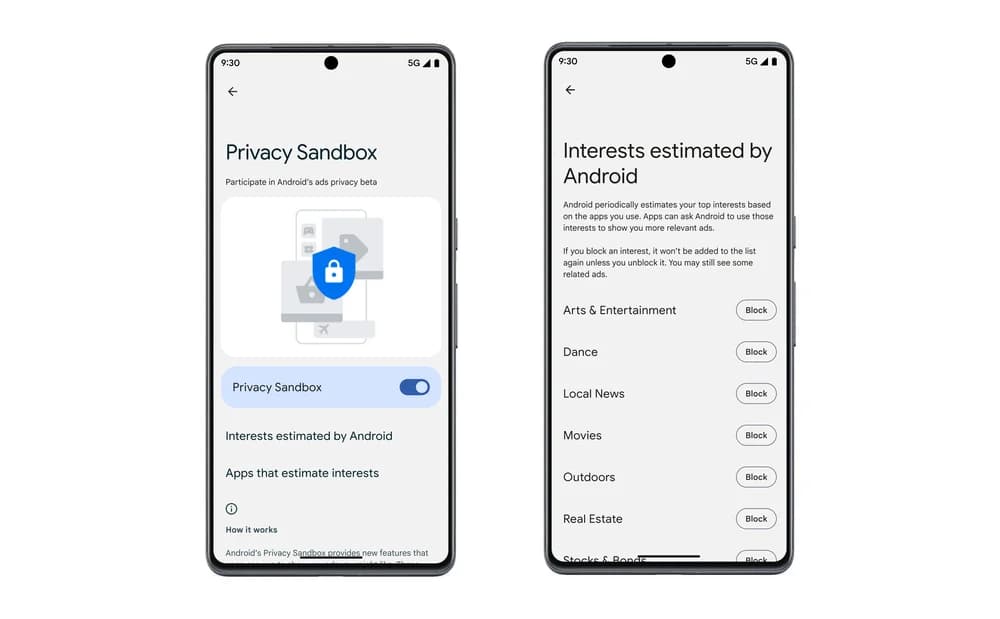Privacy Sandbox on Android beta launched: here we go
Google just launched Privacy Sandbox on Android in beta, and it feels like the Titanic set sail. Or the first space shuttle took off. Or the first rocket succeeded in nailing a vertical landing. Because it’s that big of a deal, even though it’s just, really, a very initial step.
Privacy Sandbox on Android is the yang to Apple’s yin: App Tracking Transparency. And it’s finally getting close to reality.
The privacy era of mobile
“Over the past year, we’ve worked closely with the industry to gather feedback and begin testing these new technologies,” Google privacy VP Anthony Chavez wrote today on The Keyword. “Today, we’re entering the next phase of this initiative, rolling out the first Beta for the Privacy Sandbox on Android to eligible devices. With the Beta, users and developers will be able to experience and evaluate these new solutions in the real world.”

We’ve been entering the vendor-driven privacy era on mobile ever since Apple created the IDFA. (Yes, even though the IDFA became the poster child for violations of privacy, it was better than an eternal, unchangeable device identifier, the UDID.) Apple’s launch of App Tracking Transparency for user choice and provision of SKAdNetwork for attribution was the next major step, but it impacts only half of the mobile operating system duopoly and only 27.6% of operational global smartphones.
Android is the big kahuna, globally.
And rolling out a privacy solution that in some ways goes farther than Apple’s ATT is a big, big deal.
Check out Singular resources on Privacy Sandbox on Android:
- MMP role in Privacy Sandbox
- Targeting via Topics API in Privacy Sandbox
- Audiences and retargeting via FLEDGE in Privacy Sandbox
- Reinventing how SDKs work with SDK Runtime in Privacy Sandbox
Participating in the Privacy Sandbox for Android beta
The initial roll-out will be very slow and very small. Select Android phone owners who have updated to Android 13 will get notifications if they’d like to participate. App publishers can also choose to opt in by using the new Privacy Sandbox APIs.
Both app marketers and people can back out of participating in the beta test at any time, but those that persist — especially marketers — will learn valuable lessons.
Google has been super-collaborative with the industry in designing Privacy Sandbox for Android, and there’s a lot to be excited about in the implementation, with tools and capabilities that outpace even Apple’s enhanced SKAN 4. That said, there’s a huge amount of complexity and change to anticipate over the next year and a half as the industry works through this, and there’s very likely significant additional changes that Google will need to make to Privacy Sandbox as the industry plays with its new measurement, attribution, targeting, and audiences toys.
There will also be significant loss.
As we’ve seen on iOS, losing the key identifier that the entire mobile advertising ecosystem was built around was a monumental shift that probably 70% of marketers have not yet fully recovered from.
(As I discussed with user acquisition expert Matej Lančarič recently.)
We are going to see similar challenges with Privacy Sandbox on Android.
Keys to success with Privacy Sandbox on Android
The keys to success are several.
One, get up to speed with the tech as soon as possible. We’ve seen that early adopters on iOS made significant strategic gains on competitors by learning SKAdNetwork quicker. Two, use the right tools. I’ve seen multiple examples of companies that almost completely paused iOS user acquisition efforts due to measurement insanity — $500 CPIs — when not using the right tools. Once they started working with Singular’s SKAdNetwork attribution and specifically Singular’s SKAN Advanced Analytics, hidden or missing data re-appeared and conversion models improved … and profitable growth could resume.
We’re likely to see similar scenarios on Android.
Privacy Sandbox vs SKAdNetwork
One thing is clear: Google is positioning Privacy Sandbox as better than SKAdNetwork for both people and marketers, calling App Tracking Transparency a “blunt approach:”
“Our goal with the Privacy Sandbox is to enhance user privacy while providing businesses with the tools to succeed online,” Chavez says. “Blunt approaches that don’t provide viable alternatives harm app developers, and they don’t work for user privacy either, leading to less private ways of tracking users like device fingerprinting.”
In other words, Google wants to protect user privacy, but it also wants to protect the mobile marketing industry.
Deprecating the GAID will certainly do the former. And the set of holistic tools that Google has built into Privacy Sandbox for Android around targeting, audiences, retargeting, measurement, and attribution certainly promise to do the latter. But there’s a lot to work on in terms of targeting granularity, just to name one thing, and other aspects of Privacy Sandbox.
Time will tell how well it all works out.
Stay up to date on the latest happenings in digital marketing


